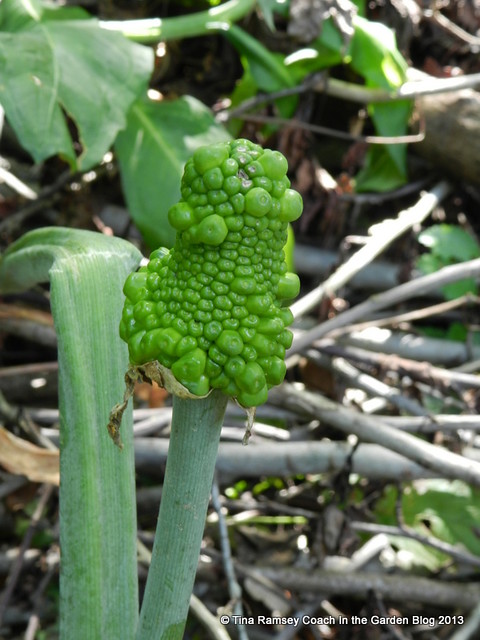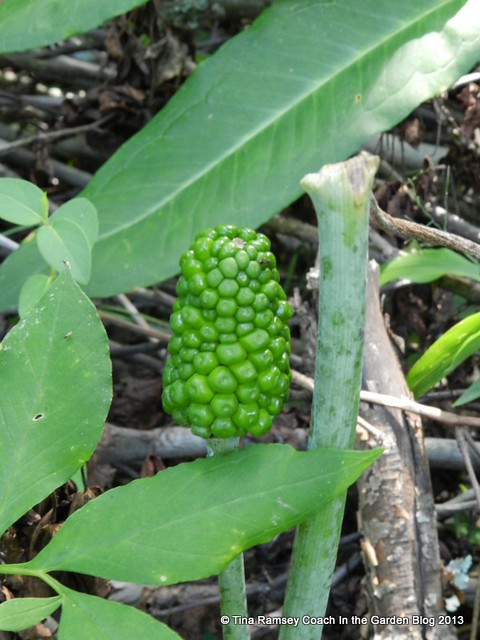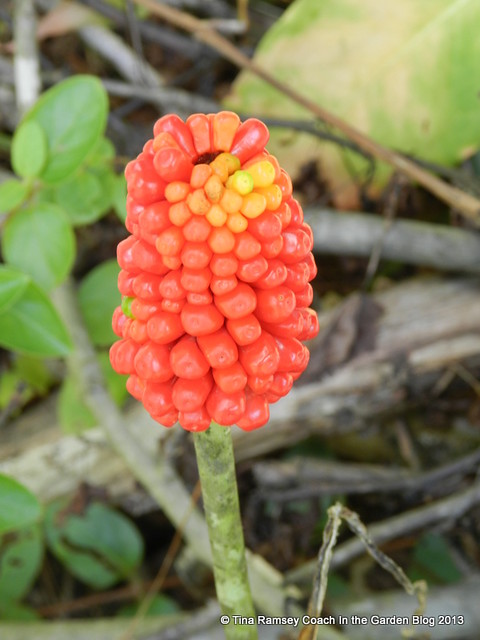
It has now been over six months since Farmer Fix-it and I purchased our nearly 60 acres of paradise in the country. Little did I know at the time how many natural treasures we would find both growing and living on the land. One such treasure is this Green Dragon, aka Arisaema draconitium.
I consider this wildflower to be a treasure because it is native and growing naturally--without any help from me or anyone else. It has found its perfect growing spot all on its own and is thriving. Native plants are wonderful in the garden but little did I know just how wonderful they are growing in the wild in their natural habitat. Does that make sense? I hope so!
We discovered these two stems of the green dragon growing near our stream back in early June. We happened to be on an old logging road that is on our property doing some clearing when I literally bumped into this plant. As in I backed the trailer over it. Fortunately, the plant was not too badly damaged and still flowered and set seed. I will have to be much more careful in the future. In the heat of clearing twenty plus years of growth one gets a bit determined to clear everything, even if that means taking out some desirable native plants. I am now slowing down a bit and rethinking just how much I wish to disturb the property. We do still need to clear the sassafras, persimmons, and PESKY sumac, but I'd like to do it in a manner that preserves the native grasses such as Little Bluestem, American Columbo, and all the other wildflowers growing out there on the property. It is a fine line between clearing and disturbing I tell you. Farmer Fix-it and I are getting quite an education. I think it is important to keep the land cleared where it has already been cleared, yet, I wish to maintain the delicate balance established by the pioneering species that moved in once the previous owner had the land cleared with a bulldozer. This means the trees will have to go and I will have to take care of the undergrowth and grasses that provide shelter and nourishment for the local fauna such as grouse, deer, and woodland birds. It is a long process and I'll post on it as I am able to.

The two stems of our green dragon each had a flower spathe. The flower is similar to a Jack in the Pulpit flower. It is not a significant flower at all but kind of cool.

July 21, 2013
Once the flower was pollinated it began turning into a wand that had a bunch of berries on the end of it. This is what the bloom looked like on July 21st.

August 13, 2013
Just over one month later the berries started turning a brilliant red orange. Now the plant is a little more noticeable in its natural environment. The actual plant is going dormant while these berries are taking over. Our green dragon is growing on the edge of woods at the bottom of a very long hill. The soil is quite acid and moist due to runoff from the hill and from the nearby stream. Our soil is also full of clay and retains water quite well. In a cultivated garden this plant would probably work well in a rain garden but in the wild it is quite rare and, as with most wildflowers, should be left alone. I will certainly not try to move my wildflower and will enjoy it growing in its natural environment....

3 September 2013
in the garden....
What an interesting plant and to think it just grows naturally on your property. A treasure indeed.
ReplyDeleteHave a nice weekend ~ FlowerLady
I'm sure you have all kinds of jewels hiding in the growth on your property, but saving them while clearing the undesirables has to be very difficult. Glad you were able to spot the Green Dragon in time to save it.
ReplyDeleteSpeaking of growing in the wild vs. in the garden, I think it's kind of funny that many of the natives I've tried to plant in my garden don't survive, yet masses of them thrive along the roadsides. I guess Mother Nature prefers to do her own thing.
Wow, a Berry Bloom! This is a most interesting plant Tina! You have so much more to explore and in time, I am sure you will find more native treasures on the land. What fun to discover these treats!
ReplyDeleteWhat fascinating treasures of native plants you must be discovering! Have you ever thought of trying to restore native vegetation in some parts of the land that were cleared by the former owner? It sounds like it would be a fascinating project - and like you've got the building blocks all around you.
ReplyDeleteTina, We have 10 acres that were basically overgrazed pasture with a draw going through them when we moved here almost 7 years ago. We're working to restore native vegetation on almost all of it - although it's definitely a "learn as we go" sort of process. I'd love to discuss what we've learned/are learning and hear what's going on as you're settling in to your new place too. My e-mail is cynthabbott at yahoo. Cynthia, aka Gaia gardener
ReplyDeleteI've never seen this one. It is a beauty. You will find lots of treasures as time goes by.
ReplyDelete♪♫° ·.
ReplyDeleteNão conheço essa planta mas é tão bom encontrá-la no seu habitat natural.
Bom fim de semana!
Beijinhos do Brasil.
♪♫° ·.
º° ✿✿ ·.
I like it! I've been basically trying to
ReplyDeletedo the same thing on my measly oak shaded two acres. Less grass to mow and more wildflowers to enjoy is my new motto...:)
Very lucky indeed to find them growing in the wild...
ReplyDelete